 |
A Horsetail Pan
Flute
|
| Strolling by a patch of horsetail (Equisetum
hyemale), it is hard to resist cutting a length of this slender,
abrasive plant and blowing across an open end for its sharp whistle
effect. Upon witnessing a friend play his pan flute one day, I
realized that I could fashion one out of horsetail. This horsetail
pan flute is easy to make, but takes patience and dexterity,
especially when securing each piece of horsetail to the frame. I
initially made the mistake of using fresh horsetail when assembling
my first pan flute. This resulted in whistles that shrank away from
the frame and the yucca bindings, as well as buckled into
unattractive, tone-less hanks of horsetail. It seems very important
to thoroughly and slowly dry whole horsetail stems in a cool place
devoid of direct sunlight. For my material in my locale, this
process took three weeks. |
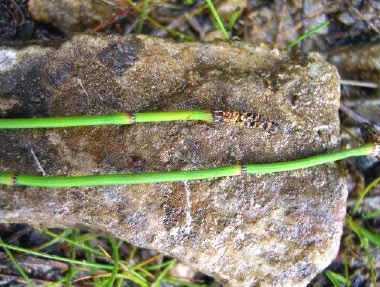 |
| |
|
|
| |
| The next step is to cut the horsetail
into suitable lengths to produce whistles of different pitches. I
find that using a swift chopping motion with an antler cleaver works
well, giving a clean cut without crushing all of the horsetail. [afternote--I
have found that using a sharp obsidian shard works better and
doesn't crush the horsetail]. |
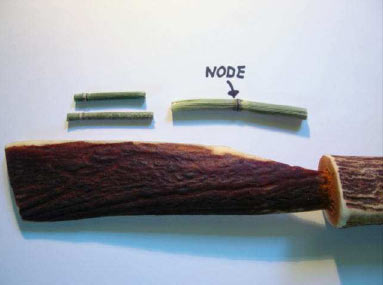 |
| |
| When cutting horsetail into whistles,
you don’t want pieces that are totally hollow. One must leave an
intact node, or cross-wall, inside the length of each piece. Some
species of Equisetum branch at these nodes. I have not had success
making whistles out of these species. Experiment, experiment,
experiment! |
 |
| |
| Knowing nothing about music, I cut a
couple hundred pieces and blew away, setting aside those that
“sounded right.” Generally, the longer and/or wider the piece, the
lower it will sound. Coincidentally (I whimsically prefer
instinctively), when I finished selecting those whistles I deemed
good enough to affix to a frame, a musician friend informed me that
my arrangement decently coincided with a nearly two octave scale,
starting with a C (438 Hz). |
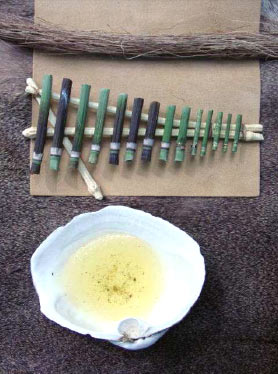 |
| |
| For the triangular frame, I chose
clematis, which was light and handy. Here was the most difficult
part of this endeavor—attaching the horsetail to the frame, which
proved to be intricate and taxing to my dexterous capabilities.
In the photos you can see the grand fir pitch and yucca fibers I
used to attach the whistles to the frame. After I tied the frame
together with yucca, I glued each whistle to the frame using the
heated pitch. Upon drying, I then tied the horsetail to the frame
with a yucca fiber, with the thicker fibers being more reliable (but
be careful not to crush the horsetail when cinching down your
knots!). |
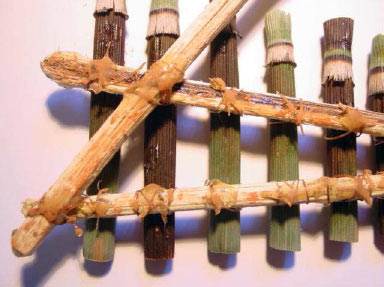 |
| |
| Occasionally a whistle would dislodge
from the frame with handling, so re-application of pitch was
necessary. When each whistle was finally tied to the frame, I
re-enforced the bindings with a drop of heated pitch. On the
finished product I rubbed ochre rock dust on all pitched surfaces to
eliminate stickiness. |
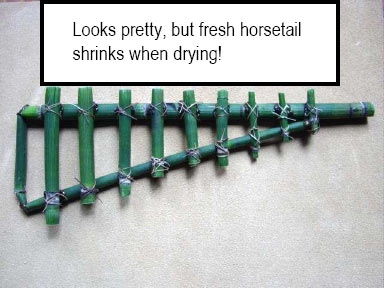 |
| |
| This is a great activity to do with
kids: it gives them a real connection with their environment;
utilizes a widespread resource (here in the Pacific Northwest); and
produces a final product that their parents don’t mind them having
(as opposed to, say, a stone blade). Enjoy! |
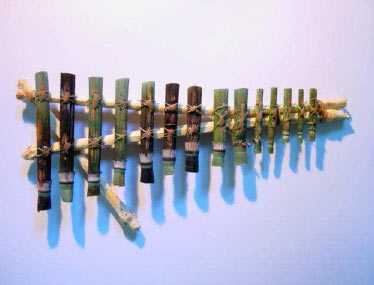 |
| |
| View this article as a PDF |
|
|
|
 |
 |
 |



